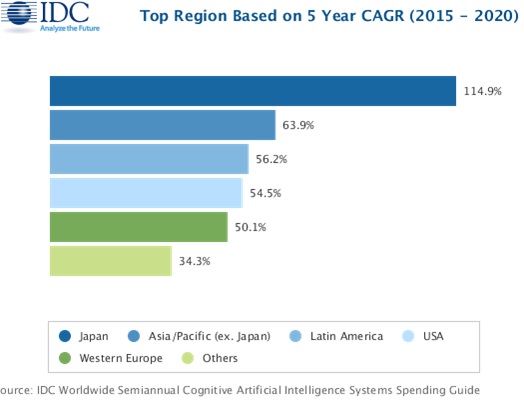Corporate Spending on AI to Approach $50 Billion in 2020
IDC has a new research report out suggesting that corporate spending on Artificial Intelligence initiatives topped $8 billion in 2016 and is likely to reach $48 billion in 2020. That is a 55% compound annual growth rate (CAGR). The Wall Street Journal (paywall) offers several examples including AIG, Fannie Mae and Massachusetts General Hospital. AIG is using deep learning neural networks to optimize IT infrastructure performance. Network devices outages have that used to take 3.5 hours to fix are now addressed in an average of 10 minutes by virtual assistants working in concert with IT staff.
Fannie Mae used to write up lengthly reports on its 100 most important customers once a year. It now uses a natural language process (NLP) system to comb through credit and activity data on its customers and delivers reports on 6,000 companies each quarter. Mass General is using AI to evaluate CT scans. The Guardian reported last week that the Japanese company Fukoku Life Insurance is now using IBM’s Watson AI solution to calculate payouts to policy holders. That system is enabling the company to eliminate 34 employees from the payroll at save 140 million yen annually.
“Software developers and end user organizations have already begun the process of embedding and deploying cognitive/artificial intelligence into almost every kind of enterprise application or process,” said David Schubmehl, research director, Cognitive Systems and Content Analytics at IDC.
Half of Spending By Four Industries
The IDC report estimates that 50% of current AI corporate spending is focused in just four industries: banking, retail, healthcare and discrete manufacturing. Banking and retail alone comprised about $1.5 billion each in 2016 spending. The majority of the spending is for software. The two major software categories were listed as cognitive applications and cognitive platforms borrowing from IBM’s preferred terminology. The balance in spending is for hardware to run the systems.

North America accounted for 77.5% of 2016 spending on AI followed by Europe, Middle East and Africa (EMEA). However, Japan and Asia/Pacific are expected to have the fasters growth rates over the next four years with Japan nearing a 115% (CAGR).
With AI headed for $50 billion in annual spending and a growing list of successful use cases, it is fair to say that the sector is well beyond novelty status.
Follow @bretkinsella
Japanese Insurance Company Replaces Office Workers with IBM’s Watson
Artificial Intelligence Primer from Frank Chen of Andreessen Horowitz
Voice Will Be the Primary User Interface Says Lola’s Bryan Healey








